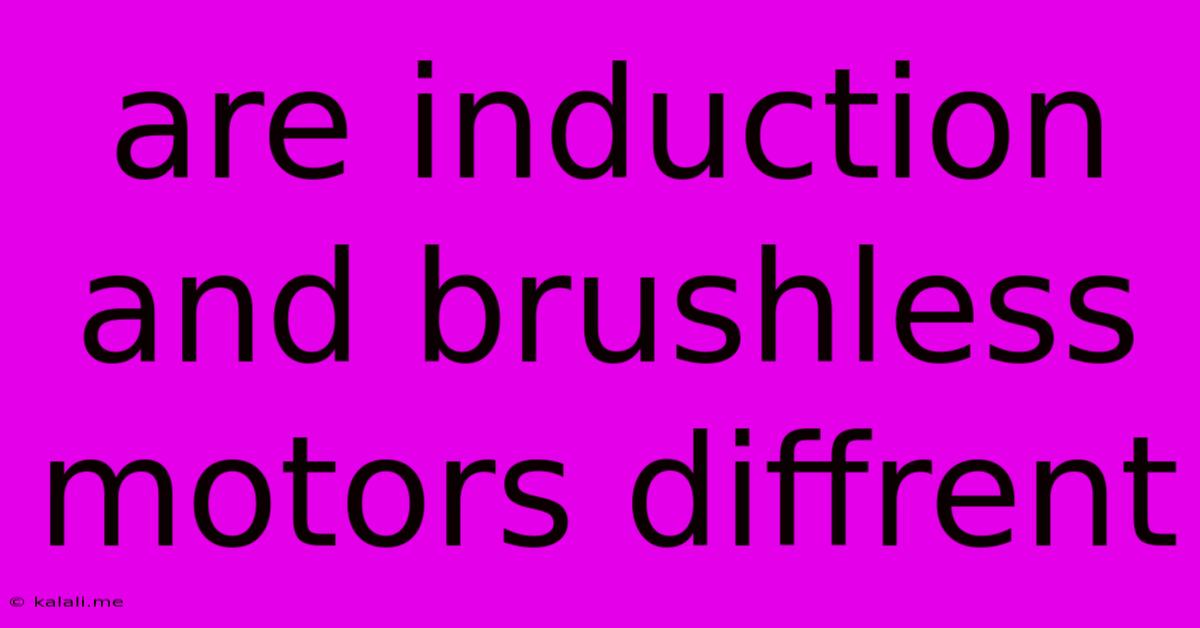Are Induction And Brushless Motors Diffrent
Kalali
Jun 02, 2025 · 3 min read

Table of Contents
Are Induction and Brushless Motors Different? A Deep Dive into AC Motor Technology
Are induction and brushless motors different? Yes, while both are types of AC (alternating current) electric motors offering high efficiency and performance, they differ significantly in their construction, control mechanisms, and applications. This article will delve into the key distinctions between these two powerful motor technologies. Understanding these differences is crucial for selecting the right motor for your specific needs.
Understanding the Fundamentals: Both induction and brushless DC motors are used in a wide array of applications, from electric vehicles and industrial automation to household appliances and robotics. They both convert electrical energy into mechanical energy, but they achieve this in fundamentally different ways.
Induction Motors: The Workhorse of Industry
Induction motors, also known as asynchronous motors, are arguably the most common type of AC motor. Their simplicity and robustness make them ideal for numerous industrial applications. They work on the principle of electromagnetic induction:
- Construction: Induction motors comprise a stator (stationary part) with windings that create a rotating magnetic field, and a rotor (rotating part) with conductive bars or windings (squirrel cage or wound rotor).
- Operation: The rotating magnetic field in the stator induces currents in the rotor, creating a magnetic field that interacts with the stator's field, causing the rotor to turn. The rotor speed is slightly less than the synchronous speed of the rotating magnetic field (hence "asynchronous").
- Control: Traditionally, induction motors are simple to control, often requiring only a connection to the power supply. However, more advanced control techniques like Variable Frequency Drives (VFDs) are commonly used for precise speed and torque control, boosting efficiency and responsiveness.
- Advantages: Robust, simple design, low cost, high reliability, readily available.
- Disadvantages: Lower efficiency at lower speeds compared to brushless DC motors, can be more challenging to control precisely for high-performance applications.
Brushless DC Motors: Precision and Efficiency
Brushless DC (BLDC) motors represent a sophisticated alternative to traditional brushed DC and induction motors. They are known for their high efficiency, precise control, and long lifespan.
- Construction: BLDC motors consist of a stator with permanent magnets and a rotor with windings. The windings are energized sequentially by electronic controllers to create a rotating magnetic field that interacts with the stator's permanent magnets.
- Operation: A sophisticated electronic controller manages the commutation (switching of the windings) to create continuous rotation. The controller precisely times the energization of the rotor windings to maximize torque and efficiency.
- Control: BLDC motors require electronic controllers for operation, allowing for precise speed and torque control, often with advanced features like sensorless operation and regenerative braking.
- Advantages: High efficiency across a wide speed range, precise speed and torque control, longer lifespan due to the absence of brushes, quieter operation.
- Disadvantages: Higher initial cost, more complex control circuitry required.
Key Differences Summarized:
| Feature | Induction Motor | Brushless DC Motor |
|---|---|---|
| Rotor Type | Squirrel cage or wound rotor | Wound rotor with permanent magnets in the stator |
| Control | Simple or VFD-controlled | Requires electronic controller |
| Commutation | Naturally induced in the rotor | Electronic commutation |
| Efficiency | Generally lower, especially at lower speeds | Typically higher across a wider speed range |
| Cost | Lower initial cost | Higher initial cost |
| Maintenance | Less frequent maintenance | Less frequent maintenance |
| Applications | Industrial applications, fans, pumps | Electric vehicles, robotics, precision tools |
In conclusion, while both induction and brushless motors are powerful AC motor technologies, they have distinct characteristics. The best choice depends heavily on the specific application requirements, considering factors like cost, efficiency, control precision, and maintenance needs. Induction motors remain the workhorse for many industrial applications, while brushless DC motors excel in demanding applications where high precision and efficiency are paramount.
Latest Posts
Latest Posts
-
How To Install Threshold Strip Between Hardwood And Tile
Jun 04, 2025
-
Minecraft Does The Launcher I Use Affect Performance
Jun 04, 2025
-
Lord Of The Rings Orc Names
Jun 04, 2025
-
United States Email Providers Combo List 3m
Jun 04, 2025
-
How Much Is A Half Dozen
Jun 04, 2025
Related Post
Thank you for visiting our website which covers about Are Induction And Brushless Motors Diffrent . We hope the information provided has been useful to you. Feel free to contact us if you have any questions or need further assistance. See you next time and don't miss to bookmark.